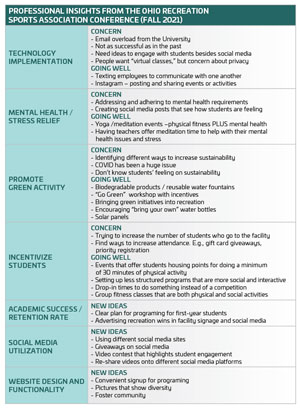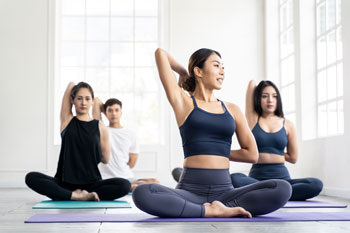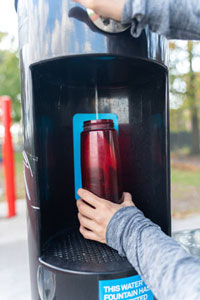By Zackary Ziegler, Julia Morris, Caitlin Blair & Peter Titlebaum
The rise of Gen Z has led to a wave of cultural beliefs and ideologies in and outside of campus recreation. As indicated in Recreation Management’s 2022 State of the Industry Report (June 2022), on average, colleges and universities are investing more than $7.6 million into improvements to campus sports and recreation facilities to gain competitive advantage over other institutions. The connection between the retention rate of an institution and its students’ campus recreation usage rate is a valuable metric. Campus recreation can capitalize on this by effectively marketing these facilities and programs to Gen Z, subsequently fostering student retention. The following is a list of campus recreation programming that can engage and win over this new generation of facility users.
1. Programming that combines ease of technology with real-time results.
There have been vast advancements in the state of technology since the  birth of Gen Zers. In all aspects of life, Gen Z is in constant connection with technology and its helpful features. The intersection of technology and fitness is made evident by brands such as Peloton, MIRROR, Fitbit and Apple Watch. This equipment may not be within the reach of all college campuses, but other enticing programming still can be implemented. The real-time stat tracking of spin cycle classes is an example. There are companies creating a whole experience immersed with a leaderboard that shows the progress of riders during a workout. Afterward, participants are able to see stats about their performance, including calories burned. This experience visually and technologically taps into the interests and expectations of Gen Z as they engage with campus-provided physical exercise facilities and programming.
birth of Gen Zers. In all aspects of life, Gen Z is in constant connection with technology and its helpful features. The intersection of technology and fitness is made evident by brands such as Peloton, MIRROR, Fitbit and Apple Watch. This equipment may not be within the reach of all college campuses, but other enticing programming still can be implemented. The real-time stat tracking of spin cycle classes is an example. There are companies creating a whole experience immersed with a leaderboard that shows the progress of riders during a workout. Afterward, participants are able to see stats about their performance, including calories burned. This experience visually and technologically taps into the interests and expectations of Gen Z as they engage with campus-provided physical exercise facilities and programming.
2. Programming and resources that allow students to be more mindful.
The need for mental health support and resources has dramatically increased because of Gen Z. The National Alliance on Mental Illness reports that, in the past year, more than 25% of college students have a mental health illness. In addition, more than 80% of college students have felt overwhelmed by their daily routines in the past year. These stats clearly show how prevalent mental health-related issues are in the lives of college students that could be improved by using campus recreation facilities. Programming like yoga can help Gen Z develop relaxation techniques, which can equip them with coping tools to ease stress, thus having a positive impact on their overall mental health.
College recreation needs to look at programming differently to help students counteract some of these newer negative trends. They could help validate the experiences of this generation of students while also providing tools to help combat mental health struggles. Campus recreation could develop programming that helps combat stresses in student lives beyond yoga. In addition, they can amplify the positive impact by employing technology that acts as a vehicle for students to allow them to feel heard and supported. Kelly Naylor, president of designFitness, feels that “mindfulness is a hot button and shouldn’t be overlooked when trying to capture the Gen Z
market.”
3. Marketing and programming that truly incentivizes students to engage.

More than previous cohorts, Gen Z craves acknowledgement for their hard work. As found in a study in 2018, 87% of Gen Z values rewards. Campus recreation should tap into incentive-based programming and marketing in order to encourage this population. Developing a simple point-based system that awards students who are more active in campus recreation can go a long way. For example, students who attend several group fitness classes can earn raffle tickets for prizes such as T-shirts, water bottles or gift cards to restaurants near campus.
Awareness of these incentives can be achieved through social media promotion. Gen Z relies on social media more than any other source of information. Students can also be incentivized with special benefits or prizes for finding ways to advocate for campus recreation on social media platforms. It can be powerful and effective to receive direct promotion from the individuals who actually use a facility. Word-of-mouth promotion is a highly effective form of advertising to motivate consumers. Social media has made this kind of promotion a lot more accessible.
4. Catering to the needs and interests of all niches of students.
The type of programming offered in campus recreation plays a large role in the usage of the facility. A 2014 study titled “The Benefits of Campus Recreation” looked at the impact of campus recreation on students. As stated by Dr. Scott Forrester in the study, “62% of students report that campus recreation programs influenced their decision of which college/university to attend.” This clearly indicates the importance of capturing the attention of different groups of people with a variety of programming that appeals to multiple interests.
Intramural sports is one example. Not all students have a deep interest in traditional intramural sports. Less-competitive sports that foster teamwork and entertainment should be considered. Unique team competitions such as battleship, bubble soccer and capture-the-flag can have broader appeal to the non-athlete. In addition, single-day tournaments can entice participants to engage in campus recreation without taking on a serious commitment.
5. Commit to sustainability practices and address social justice issues.

As indicated in an article in Sporting Good Business in 2021, 83% of Gen Z survey respondents consider themselves environmentalists. This generation of students firmly believes in saving the planet through conscious environmentally friendly efforts. Campus recreation needs to promote its own sustainability efforts in order to capture the attention of Gen Z and earn respect. Simple enhancements to facilities such as a water-bottle filling station can help save water and encourage users to bring a water bottle. Lots of trash can be eliminated at campus recreation facilities and promoting recycling can show care for the environment. Campus recreation can even offer workshops that educate students on how to live a sustainable life in college with a fitness twist.
People from the Gen Z cohort are serious social justice advocates. Students expect organizations and brands to voice their support for people who are marginalized and underrepresented. Authentic brand messaging that
supports groups of minorities will appeal to more than just the population showcased. General awareness social media campaigns and campus recreation events that allow marginalized groups to feel heard is important to Gen Z values. Examples include health care, mental health, economic security, racial equity and the threat of climate change.
Summary
A goal of intramural sport activities is to help drive participation rates and introduce more people to campus recreation. Programming in every facet of campus recreation can reach all niches of students. Sport clubs can attract the student body with alternative programs such as quidditch, spikeball, ultimate frisbee, table tennis, and pickleball. Adjustments such as designated hours in the weight rooms that are available to less experienced lifters can broaden appeal of this type of exercise. It can help create a welcoming atmosphere where participants do not have to feel intimidated when observing serious weightlifters. RM
ABOUT THE AUTHOR
Zackary Ziegler is an undergraduate at the University of Dayton studying Sport Management. Julia Morris is an undergraduate at the University of Dayton studying Sport Management. Caitlin Blair is an undergraduate at the University of Dayton studying Sport Management. University of Dayton Professor Peter Titlebaum’s areas of expertise include marketing, sales, fundraising, activation, return on investment and return of objective strategies.



